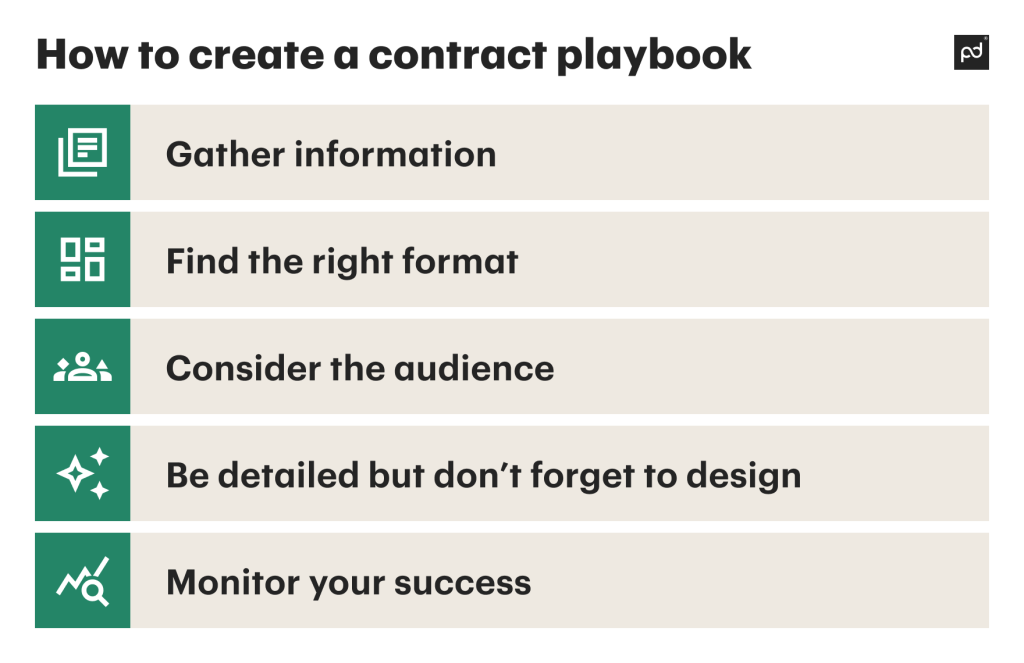Building contracts can be a time-consuming, resource-heavy, and expensive process.
So, what’s the alternative? This article will explore how a contract playbook could be the solution to your problems.
We’ll cover everything from the contract playbook definition to their uses and benefits. We’ll then show you how to create one and how PandaDoc can help.
Key takeaways:
- A contract playbook serves as a roadmap for businesses when creating contracts.
- Having one in place frees up your legal team and means staff can find necessary information and write contracts themselves.
- Contract playbooks improve workflows and allow contracts to be completed quicker.
- Simplify your contract creation process further with a robust contract management system.
What is a contract playbook?
A contract playbook is a document compiling everything you need to know about contract writing.
There are many steps involved in creating a contract, from initial negotiation to signing and management.
Each can involve considerable research.
Additionally, legal teams may have to be involved to ensure the document is legally compliant.
You might even need the help of a lawyer.
If handled poorly, this process can be highly detrimental to your business.
Instead of working on valuable, growth-related activities, teams become bogged down in admin and create ineffective contracts that do nothing to protect your interests.
With the help of a contract playbook, however, teams have a roadmap to guide them.
They gain easy access to a plethora of helpful information covering all aspects of contract creation.
Typically, a playbook will contain the following information:
- Best practices for negotiating a contract.
- How to collaborate with different teams during compilation.
- How to properly review a contract.
- Legal advice for remaining compliant with the law.
- Information relating to formatting and structuring a contract.
The format of a contract playbook is largely down to the organization creating it.
Some businesses choose to use spreadsheets and programs like Microsoft Excel.
Others create documents in Microsoft Word or Google Docs.
Contract playbooks are often used alongside contract management software to ensure compliance and reduce the likelihood of errors.
What is a contract negotiation playbook?
“Contract negotiation playbook” is a term that’s usually interchangeably with “contract playbook”.
As explained above, these contain legal information to help teams create compliant contracts.
Let’s now delve into their role and usage in more detail.
All your contracts must comply with the law.
Without proper care and attention to relevant rules and regulations, you might be fined or face other legal issues.
Legal teams can be asked to review individual contracts to ensure compliance — but this diverts them from other vital tasks.
A contract negotiation playbook helps avoid this issue.
When a negotiation playbook is created, your legal team should be tasked with writing any sections relating to legislation.
This means that when other departments have a legal query, they can consult the playbook rather than busy team members.
They can use this to find the necessary information and write the contract themselves. This helps reduce the strain on legal teams during contract creation.
Imagine HR is creating an employment contract for a new employee.
They need to ensure the agreement is compliant with relevant regulations. Normally, they’d have to bring in legal to add any clauses.
Instead, they can consult your newly created contract negotiation playbook.
This will instruct them on best practices and help them onboard employees in a compliant manner.
Of course, your legal team can still be brought in to deal with more complex matters.
But for routine procedures, you can reduce the hours required from them and free them up for more specialist tasks.
What is a commercial contract playbook?
A commercial contract playbook is used in commercial businesses, i.e., those that sell goods or services. It outlines the company’s general approach to contracts.
Each company will have a set of terms that they include within their agreements, and most will approach negotiations with a pre-determined stance.
They will have a clear line of what contractual terms are and are not acceptable to them.
All these areas are addressed within a commercial contract playbook.
This document will also outline how far it is okay to negotiate and alter specific terms.
Ultimately, an effective commercial contract playbook should accomplish several things. These include:
- Ensuring that both legal and sales teams are on the same page.
- Reducing the risk of an unsatisfactory contract.
- Allowing deals to be completed more quickly.
To create the best possible playbook, you need to consider your business’s approach and strike a delicate balance between too much and too little wriggle room.
A playbook needs to be firm, ensuring you get the best deal, but it shouldn’t leave your teams with no leverage to negotiate.
The purpose of a contract playbook
Now, what exactly is the purpose of a playbook?
Organizations use these documents for many different reasons. Below, we’ve compiled some examples.
To provide a roadmap
When writing a contract, teams need to know exactly what procedures to follow.
What rules must be adhered to? What tone needs to be set? The playbook should provide the answers to these questions.
To improve workflows
When creating contracts, workflows can get muddled.
Who’s in charge of writing each section?
A playbook specifies roles for each team, helping avoid confusion.
To reduce the strain on legal
With the correct information, teams can create agreements without consulting a specialist.
This means your legal team can be involved less often, leaving them free to focus on other tasks.
To provide better training
The business of contracts can be highly confusing, but a playbook offers an easily accessible resource for employees.
Staff can educate themselves on the contract lifecycle.
Ultimately, this will help them negotiate better contracts.
To complete contracts more quickly
Contracts can take a long time to compile and negotiate.
The more time a contract takes to complete, the longer it will take you to reach your goals.
The slow signing of contracts can eventually affect your bottom line — but a playbook ensures this is done quickly.
The benefits of a contract playbook
There are many advantages to a contract playbook. Let’s look at some of the most significant benefits of using one.
Speeds up the negotiation process
The negotiation of new contracts can be a long process.
At each stage, teams need to check in with legal to know how to proceed.
Delays then begin to slow necessary discussions between parties.
At the same time, progress on valuable legal tasks is halted.
A contract playbook can give the negotiation process a boost. With the correct information, teams can learn how to negotiate themselves.
With less back-and-forth, you can also reduce delays and have contracts signed more quickly.
Reduce spending on legal advice
Organizations without legal teams can spend a lot of money on contract creation.
You may require a lawyer to get the legal advice you need when writing them.
Even with a specialist team at your disposal, you may need a large workforce to process the volume of contracts you’re drawing up.
Without a playbook, your organization can become heavily reliant on its legal team — to their detriment.
Once a playbook has been created, however, teams have instant and easy access to the information they need.
This means you’ll require less external help from lawyers, a less extensive legal team will be needed to handle contracts, and those employed in legal will be able to focus on more specialist tasks.
Unify teams
The negotiation process usually involves people from several departments.
While there’s no denying that it’s useful to have various perspectives, each department will have different goals for the negotiation.
If these differences aren’t controlled, arguments can break out.
A contract playbook helps reduce disagreements.
This document should outline a clear set of expectations for every negotiation.
Instead of conflicting visions, your team will work together to meet these expectations and will better understand which individual priorities take precedence.
This ensures that everyone is on the same page.
Minimize legal risks
Every contract needs to be compliant with the law — but different types of contracts have different legislation they need to abide by.
It’s easy for teams to make a simple mistake. For example, to forget to include transaction details.
Nonetheless, compliance issues can result in hefty fines and damage to customer confidence.
Thankfully, a playbook helps ensure that teams have access to up-to-date legal information.
They outline clear processes for contract building, thus ensuring that no important details are missed.
How to create a contract playbook
We’ve established some of the benefits of contract playbooks — but how do you go about writing one?
After all, the document needs to be both accessible and highly detailed.
Any mistakes could lead to incorrect decision-making by your employees.
With this in mind, allow us to guide you through building your contract playbook.

1. Gather information
Before any work can begin, you need to know precisely what you want to include in your playbook.
Consider all the relevant information that might be required for compiling contracts.
You can source this in a variety of ways. These include:
- Studying training materials.
- Talking to senior members of the legal team.
- Looking at archived contracts.
- Using online resources such as contract templates.
2. Find the right format
It sounds simple, but choosing the correct format for your playbook is essential.
Consider how you want to present it.
Below are three options you could opt for, but remember that there’s no right or wrong answer.
- A spreadsheet. Programs like Microsoft Excel provide unlimited columns, making them a good option for inserting more complex instructions.
- A word processor. A PDF created in a program such as Google Docs is a common choice. There’s the flexibility to add detailed clauses, although you’ll be restricted when adding columns.
- A physical document. A physical document can be stored in a filing cabinet and accessed from the office. However, this option isn’t ideal for most modern businesses as workforces tend to be spread out.
When selecting a format for your playbook, prioritize speed and accessibility.
It’s a good idea to ask yourself which option will be best for giving employees the information they need quickly.
3. Consider the audience
Ask yourself, “What should a reader gain from reading this playbook?”.
It’s important to remember that it won’t only be addressing one group of employees.
It should be designed to meet the needs of teams from different departments, so consider all interested parties when planning your playbook.
It’s essential to think about the kind of language you’ll use.
Most teams won’t have the same level of knowledge as legal, so using complex terminology will make your playbook inaccessible to beginners.
Instead, assume the reader has only the most basic knowledge when writing for them.
Be sure to include simple, step-by-step instructions throughout. The more digestible information is, the more willing employees will be to learn.
4. Be detailed but don’t forget to design
There’s no use scrimping on crucial details.
Your playbook should provide all the information an employee needs to create an effective contract.
Take the time to explain the different workflows involved, rules, and negotiation positions that should be followed during contract generation.
Providing real-world examples can help employees to take in information better.
Of course, with so much detail needing to be included, documents can become overwhelming for readers.
That’s why it’s equally important to consider the presentation of your playbook.
Ensure information is supported by graphs, infographics, and images throughout.
Visual aids are often an effective way of reinforcing knowledge.
5. Monitor your success
Even once a playbook has been created, the hard work isn’t over.
You need to make sure your document is achieving its goal.
In other words, are the contracts created by your team accurate and correct?
If not, what areas need to be explained more effectively?
Continuously tweak your playbook as you receive employee feedback.
Contract playbook example
Let’s now look at some examples of the information that’s generally included in a contract playbook.
- Fallback positions. How far are you willing to deviate from your initial terms during a negotiation?
- Guidelines for negotiation. How should teams approach negotiation? What strategies should they follow to reach the desired outcome?
- Legal information. What legal information do teams need to know before beginning work? What legal terminology needs explaining?
- A style guide. What language and format should be used within your contracts?
- Approval processes. What steps must be taken to ensure a contract is acceptable?
- Real-world examples. What examples can be used to illustrate the point being made?
Simplify the entire contract creation process with PandaDoc
From faster negotiations to a reduced risk of compliance issues, there are many reasons to create a contract management playbook.
You need a document that’s accessible and empowers your employees to learn.
However, designing a playbook isn’t simple, and there are lots of details that need to be considered.
Using a contract playbook alongside reliable contract management software like PandaDoc streamlines the contract creation process from start to finish.
With PandaDoc’s all-in-one solution you can accelerate your workflows and make sending contracts far easier.
Choose from a library of more than 750 templates, each of which can be customized to suit your needs. With our help, you’ll be sending out effective contracts at speed in no time.
Why not try PandaDoc today to jumpstart document creation time savings in your business?
Disclaimer
PandaDoc is not a law firm, or a substitute for an attorney or law firm. This page is not intended to and does not provide legal advice. Should you have legal questions on the validity of e-signatures or digital signatures and the enforceability thereof, please consult with an attorney or law firm. Use of PandaDocs services are governed by our Terms of Use and Privacy Policy.


